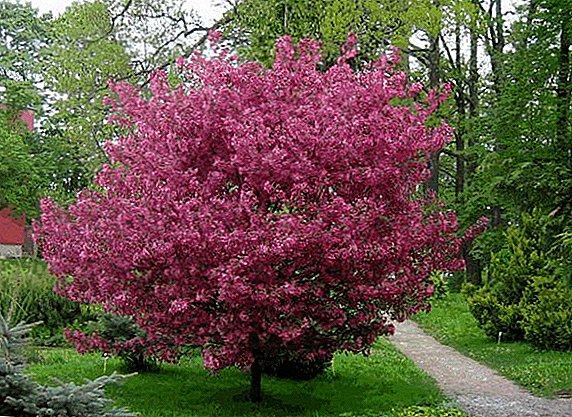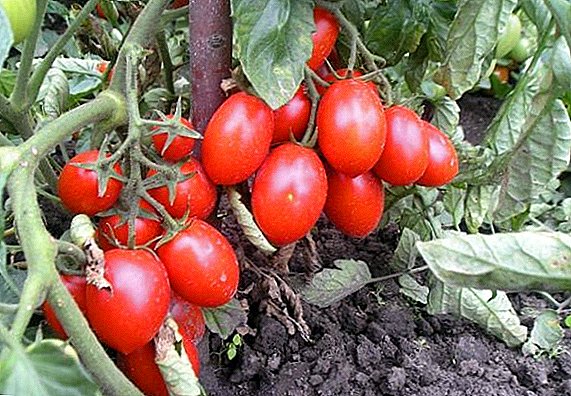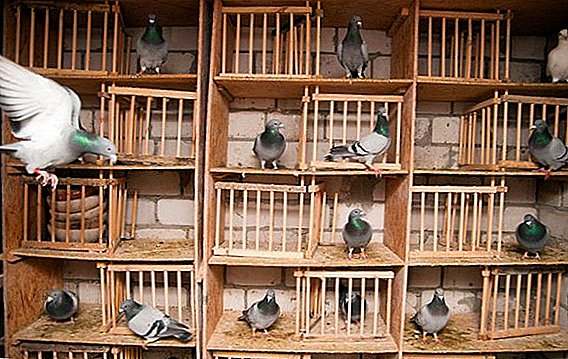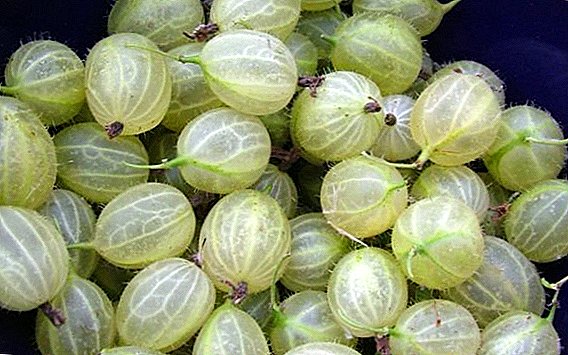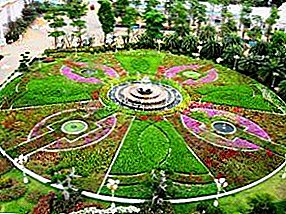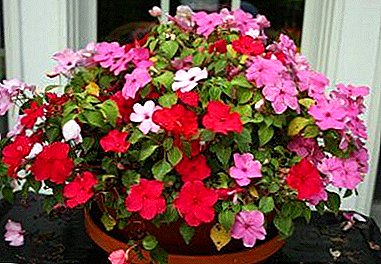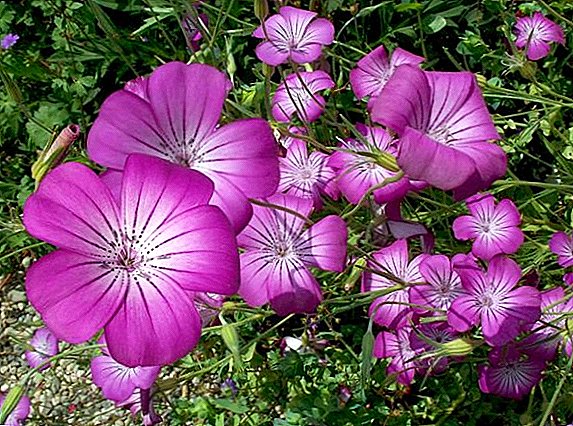 Flower growers call this elegant plant an agrostemma and grow it with pleasure in their flowerbeds, but agronomists know it as cockle - weed grass, which often occupies fields of wheat and winter crops. Why did the plant deserve such an ambiguous attitude and what is its true nature - these and other questions will be considered further.
Flower growers call this elegant plant an agrostemma and grow it with pleasure in their flowerbeds, but agronomists know it as cockle - weed grass, which often occupies fields of wheat and winter crops. Why did the plant deserve such an ambiguous attitude and what is its true nature - these and other questions will be considered further.
Kukol or agrostemma: weed or flower?
Some claim that the cockle is a valuable and very popular ornamental plant, others will argue that it is a dangerous weed to be destroyed. In fact, both statements will be truthful. In floriculture, landscape design and floristics, cockle is more often called an agrostemma and is really used for decorative purposes. This plant has elegant, beautiful flowers, looks good in single and general plantings, is used in difficult flower gardens. This plant is also often grown for cutting, as it stands in the water for up to a week with no signs of wilting and is often used to create bouquets of meadow flowers.
Did you know? In mythology, the Bible and the ancient superstitions, cockles were not ignored. In the old days, the fields on which the cockle grew were called damn niva, since they believed that the Unclean himself sowed him. There is a legend, according to which Satan made the first alcoholic drink out of the cockle, treated Eve and gave him an apple as a snack.

It is also fair to say that the cockle is a weed. This opinion is shared by farmers, gardeners and botanists. The doll is absolutely unpretentious, therefore it is able to occupy a large percentage of the area when growing cereals. It takes a lot of effort to clear the fields and harvested grain from the seeds of cockle, which, among other things, are dangerous to use.
Familiarize yourself with other weeds: creeper, creeping gorchak, creeping buttercup, clumpy pueraria, creeping couch grass, sedge grass, annual bluegrass, dandelion, Norwegian silverweed, curly thistle, wild oats and horsetail.

Botanical description of the genus
Agrostemma (Greek Agrostemma) is an annual herb from the family of Cloves. The name of the flower comes from the Greek words: "agro"and"stemma", which in translation means" field "and" wreath ", respectively. Thus, the original name of the cockle is translated as" field wreath "or" decoration of fields. "Other names of the plant: thorium, voloshka, field carnation, horsetail, doll grass.
Stems and leaves
Stems and leaves are painted in gray-green or dark green color, covered with a soft nap. The leaves are oblong, lanceolate, opposite, 4-15 cm long. The stem is straight or slightly branched, the average height is 40-60 cm. The root system is pivotal, with many thin lateral processes. 
Flowers
As with any member of the family of carnations, the flowers of the agrostemma are distinguished by their beauty, lightness, pomp and grace. Grow from 3 to 5 cm in diameter, five-divided calyx with five petals. Coloring can be different: all shades of lilac, as well as red and white shades. Flowering occurs in June-August (periods may vary in different species). Flowers have no aroma.
Did you know? Closing the flowers of a plant at night in botany is called nyktinastia. There are species in which the closure and opening of the inflorescences occurs with amazing accuracy from day to day, therefore, they were often used to build bed clocks earlier.

Types of cockle
The genus of the cockle is not rich and has only 2 registered species: ordinary and elegant cockle.
Ordinary
The first type of plant - cockle ordinary or sowing (Agrostemma githago). The stems of the common cockle reach 50-100 cm in height, branch from the middle of the main stem into several shoots, which makes the whole plant look extraordinarily magnificent. The flowers are small, solitary, lilac shaded with streaks. The flowering period is from June to July. On the basis of the common cockle, the most popular varieties of the agrostemma were bred: "Milas", "Milas Seris", "Ocean Pearl". 
Elegant
The second type is the cockle graceful (Agrostemma gracilis Boiss)whose homeland is Sicily. The annual does not exceed 50 cm in height, the stems are very branched, the flowers reach a diameter of 3 cm, are painted in various shades of pink and red, the center of the flower has a light shade. The flowering period is longer than the previous species, and lasts all summer. 
Distribution: where the cockle grows
The habitat of cockle grows over vast territories: for example, the plant can be found on the European continent, in northern Africa, Central Asia (piedmont and mountainous areas). On the territory of Russia, cockle occurs in such regions: the Far East and the Caucasus, the eastern and western parts of Siberia.
Since the plant is considered a weed in nature, it can be found on fields and crops, however, due to the improvement of agricultural technology of cultivated crops, the cockle has practically disappeared from the fields. It also grows along roads and roads on untreated soils, it can settle in gardens and forests. 
Cockle weed: damage done and ways to fight
It is important to know why cockle is dangerous and how to deal with it on the fields being processed.
What is dangerous weed
A doll is not just a weed grass that pollutes the fields of cereal - this plant is extremely dangerous when used by humans and animals. The germ of cockle seeds contains a toxic substance agrostemmin in an amount of almost 7%, which, when absorbed into the gastrointestinal tract, produces the same strong toxic effect as from intravenous administration. Therefore, if the cockle seed gets into wheat grains, the crop can be completely spoiled. 
Important! Dangerous is the content of seeds of cockle in the amount of only 0.5% in the total volume of flour or bread. Detect it in flour using microscopic analysis. Visually, this product has a bluish color, differs uncharacteristic for wheat bread bitterness and dryness.
Methods of struggle
To minimize or completely eliminate weeds from the fields, it is important to follow these control measures:
- Follow the rules of crop rotation.
- To conduct thorough weeding of cereal crops in the springtime. It is also necessary to weed winter crops in autumn, especially in the southern regions, where, naturally, an annual plant can survive a mild winter.
- After harvesting, scrupulously clean the grain from the seeds of the cockle on special grain cleaning machines (Trier machines).
- After cleaning the grain, it is important to destroy the waste and carefully monitor that it does not fall into the feed of cattle.

Flower agrostemma: conditions and rules of cultivation
If you want to decorate your plot with this elegant flower or grow it in a pot, it is important to know about some rules of cultivation. In general, the agrostemma does not differ in its demanding care, it does not undergo attacks of pests and diseases, it can completely dispense with dressings that will not adversely affect flowering and plant health. Agrostemma is the best choice for a beginner gardener and florist.
Where to plant agrostemma
Best of all, the plant feels in areas well-lit and warmed by the sun, loves a lot of light, and is characterized by drought tolerance. It prefers light, calcareous or sandy soils, but on marshy and too wet soils problems with cultivation may occur. Regarding the pH of the soil, it should be neutral or slightly acidic. If the flowers are not enough light, the stems will be weak, thin. 
How to plant an annual
The agrostemma can only be propagated by seeds, but this process is not at all difficult. Under natural conditions, seeds can retain their properties and be suitable for growth for 10 years, but when purchasing seed, it is better to give preference to last year's lot or to collect seeds on their own. The landing period is in the spring months (April, May), when the ground warms up to + 10-15 ° С. Plant can also be in the fall.
Read about annual plants such as toad grass (sicenus), Turkestan desert desert (alissum), bidens, echinocystis, iberis brachikoma, lobularia, nigella damask, Drummond phlox, argiranthemum and pentas.If the land in your area is too heavy, you can use universal purchased soil mixed with river sand in a 1: 1 ratio. It is necessary to make holes, lay 3-4 seeds at a depth of 6 cm, keeping the distance between the holes up to 20-30 cm. If the temperature of the ground and the air is high enough, the first shoots will appear fairly quickly - within 1-2 weeks. Then the sprouts need to be thinned, otherwise the plants will be too elongated, weak, there may be difficulties with flowering.

Proper care
Agrostemma is resistant to night cooling, dryness, wind, drafts. Watering it is necessary only in the period of long and intense summer heat, the rest of the time the plant does not need moisture, as well as dressings. The only thing you may need is a support in the form of a ring for high plant species. Props are also needed when thin plant stems sag under the weight of large flowers.
Useful properties of cockle and their application
Although cockle is considered a pest in the fields, it is often used in folk medicine and is an effective medicinal raw material against many diseases. Grass agrostemmy has the following properties:
- procytocytic;
- antimicrobial;
- hypnotic.

Seed-based preparations have this effect:
- anthelmintic:
- expectorant;
- hemostatic;
- diuretic.
Like cockle, they also possess diuretic qualities: chervil, mordovnik, safflower, juniper, turmeric, lavender, maple, red clover, asparagus and Siberian siksha (Altai Vodyanica).
Agrostemma is used to prepare remedies for colds, diseases of the upper respiratory tract, colic, bleeding of various nature, tumors, sleep disorders, toothache. In the form of poultices and compresses, the plant is effective for furunculosis, dermatosis and hemorrhoids.
Important! Remember that this plant is poisonous, so an independent and uncontrolled use of drugs based on it can have dire consequences. Among the symptoms of poisoning are recorded violations of the cardiovascular and central nervous systems. The use of funds must take place under the supervision of a physician!

| Violation | Ingredients | Method of preparation and use |
| Insomnia |
| Raw materials pour boiling water and insist 2 hours, covered with a blanket, strain. At bedtime, take 1/4 cup. |
| Acne, skin ailments |
| Mix, hold for 3 days at low temperature. Apply externally to the affected areas. |
| Helminthic invasion |
| Means to withstand 2 weeks, strain. Take 2 tbsp. l before bedtime. |
| Cough and cold, bleeding |
| Pour the raw material and hold for an hour, strain. During the day, take 3 times 1 tbsp. l |
For the treatment of cough also used such plants: anise, ivy, vervain medicinal, nyvyanik, wormwood, rutabaga, horseradish, saxifrage, cantaloupe and cherry plum.

Among the contraindications to the use of drugs on the basis of agrostemmy:
- the period of pregnancy and HB;
- age up to 18 years;
- allergy;
- any serious illnesses in the acute or chronic stage.
In addition to cockle, they also use in dermatology: medicinal comfrey (zhivokost), horsetail (sausage), anise lofant, asparagus, verbena, mordovnik, parsnip, peony, melon, acacia honey and feijoa.If you use drugs from the agrostema carefully and according to doctor's prescriptions, you can quickly recover from ailments. In addition, the plant is an excellent decoration of the garden or flower beds, it can be easily grown in a pot on the windowsill. However, in the case of settling in the fields, the agrostemma turns from an exquisite, delicate flower to a dangerous weed. We hope, now you understand the dual nature of this plant.


